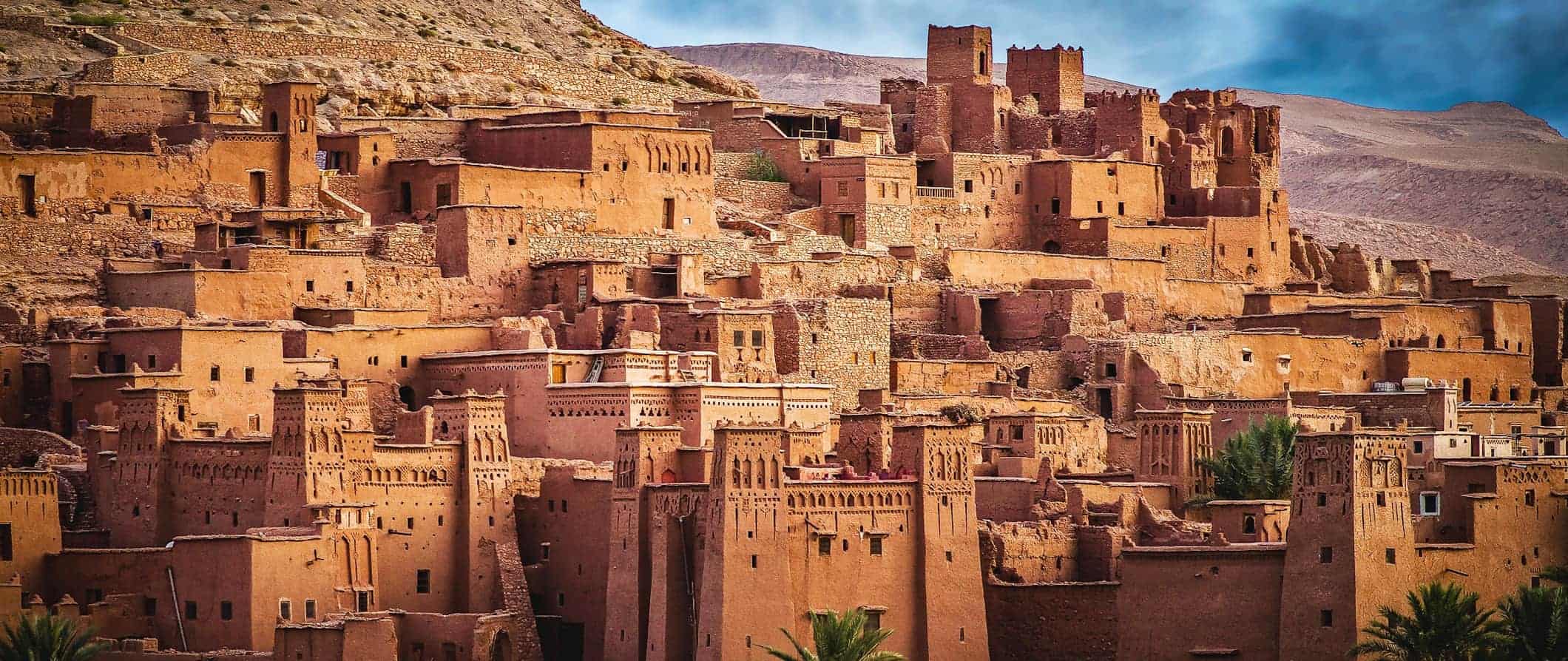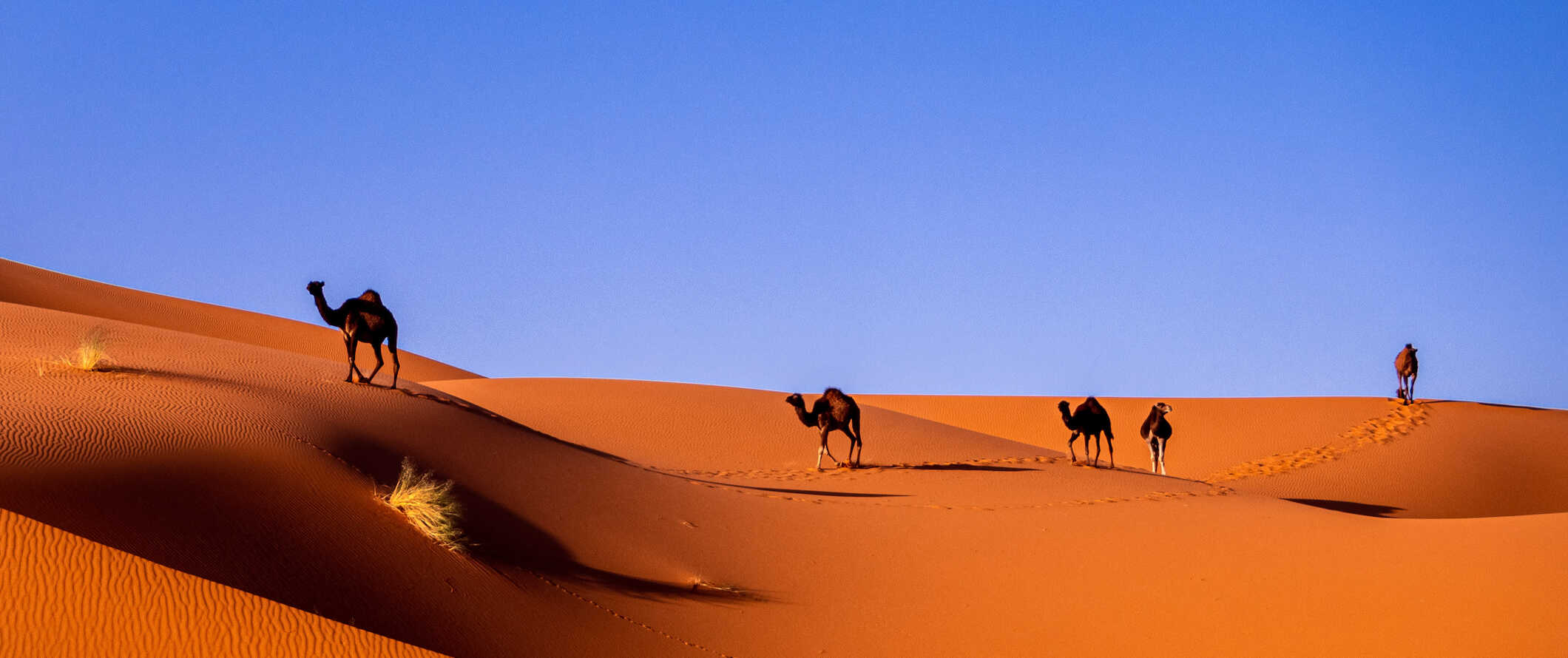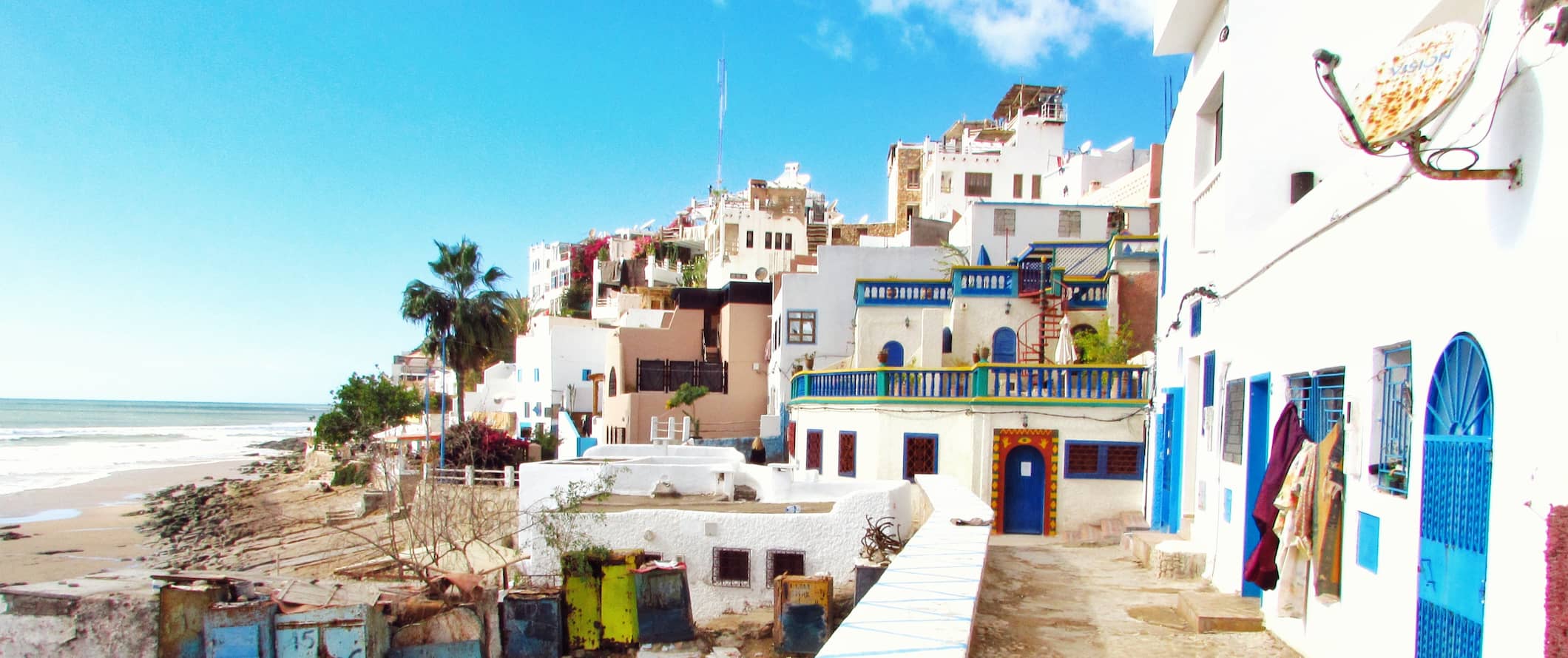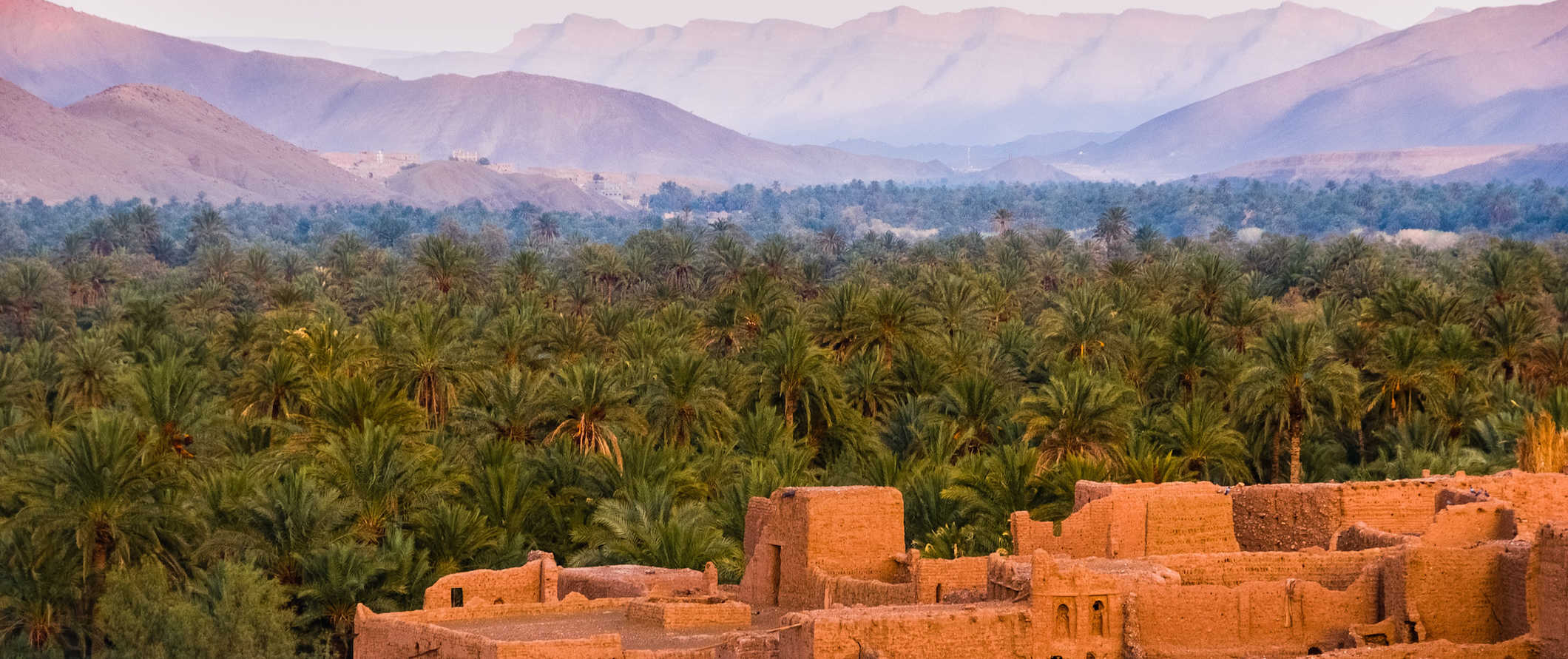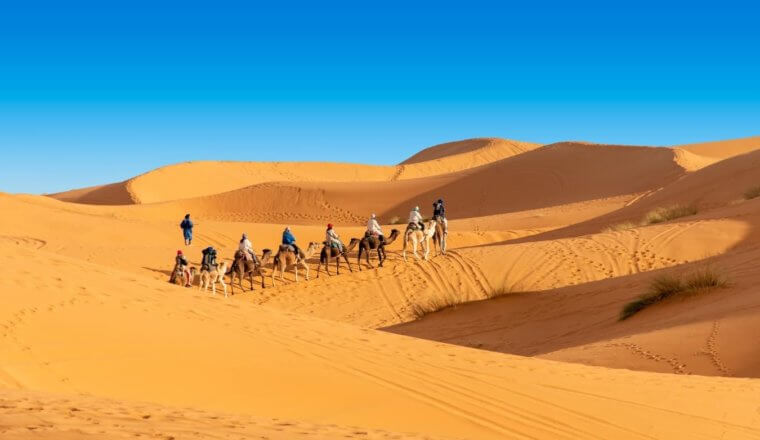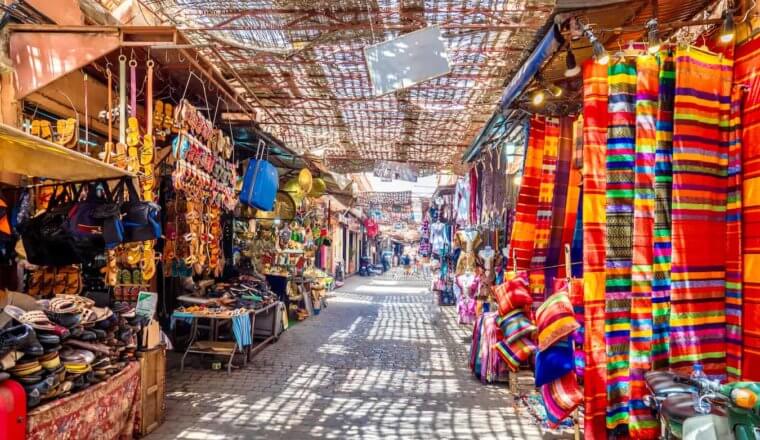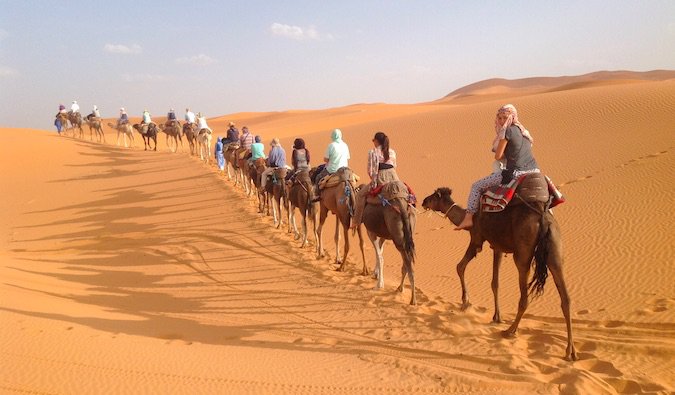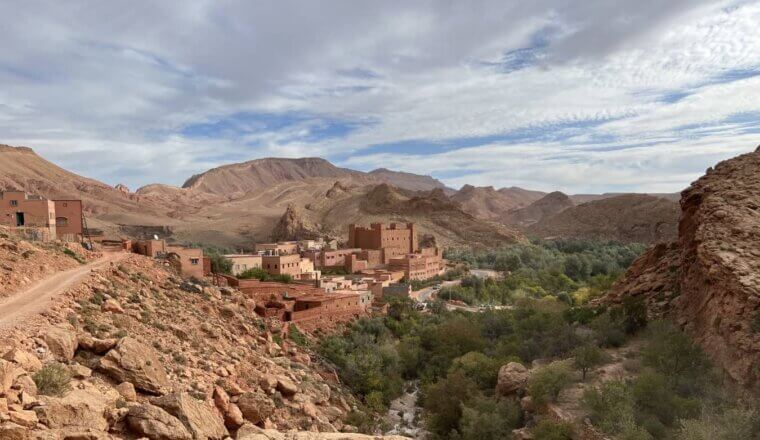Chaotic. Colorful. Eye-opening. Visiting Morocco is an intense experience. My time there was challenging, but it was also a reminder that the best part of travel is embracing the uncomfortable.
Once part of the Carthaginian Empire, the first independent Moroccan state emerged around 225 BCE as the Berber kingdom of Mauretania. That kingdom eventually became a Roman province, though, by the 7th century CE, Muslim conquest of North Africa was in full swing. A French Protectorate from 1912-1956, Morocco gained its independence in 1956 and has been an independent state ever since.
I loved my time in Morocco. I gorged on couscous, drank my body weight in mint tea, hiked, and absorbed the hectic sights and sounds of the country.
From the high Atlas Mountains to the desert to the coasts, Morocco is a marvelous country that mesmerizes. True, the sprawling and disorderly medinas can test your patience, but they reward your senses each and every visit.
Use this Morocco travel guide to plan your trip, see the best the country has to offer, save money, and avoid the common pitfalls that waylay unsuspecting travelers!
Table of Contents
Click Here for City Guides
Top 5 Things to See and Do in Morocco
1. Explore Marrakesh
Spend some time in the Djemaa el-Fna, where you can find exotic street performers, tattoo artists, musicians, and chefs. After that, wander around the medina, explore the souks, eat in the market, see the old city, and enjoy Morocco’s most international city. Marrakesh has it all.
2. Sleep in the Sahara Desert
The Sahara is vast, empty, and spectacular. Spending the night in a simple tent on the dunes was my favorite activity while in the country and I highly recommend you try it too. The stars go on forever and there’s no light pollution to block them out. (Skip the camel ride, though!)
3. Explore the blue streets of Chefchaouen
Chefchaouen is a small city located in the middle of the Rif Mountains. It is very relaxed, offers reasonable accommodations, and is visually stunning as the streets and buildings are all painted a vibrant sky blue (you’ve probably seen it on Instagram). It’s a great place to wander, shop, and sip mint tea.
4. Visit Fez
This old and powerful city is one of the best places in the country. Its narrow streets are filled with wonderful aromas, mosques, craft shops, and crowds upon crowds of people. Though Fez can be a bit overwhelming, once you get used to the pace of the city, it’s simply magical.
5. Relax in a traditional hammam
A hammam is a steam bath popular in North Africa. They are usually found near mosques or toiletry shops and can be upscale or public (traditional). Visit a no-frills traditional bath for an authentic and enlightening experience. Public hammams cost about 10 MAD, while hotel hammams cost 300-500 MAD.
Other Things to See and Do in Morocco
1. Get lost in the medinas
The medinas are the historic hearts of each city in Morocco, part residential area, part shopping center, part food market. Shops, restaurants, markets, and homes all line the twisting and turning streets in buildings seemingly too close together and too old to stay up much longer. As someone who loves to get lost, the medinas were heaven. Word of caution: The Fez Medina is a bit unsafe, so do not go too far off the beaten path. Stick to streets with lots of people or hire a guide to show you around.
2. Trek the High Atlas
The rugged and beautiful Atlas Mountains stretch over 2,400 kilometers (1,500 miles), from the West Coast of Morocco all the way to Tunisia. This mountain range is home to Jebel Toubkal, North Africa’s tallest peak at 13,671 feet. You can hike all year round, but the best time is from April to May. The Toubkal Circuit (7 days) and M’Goun Traverse (3 days) are some of the more popular treks.
3. Trek through the Todra Gorge
Located near Tinerhir in the High Atlas Mountains, this gorge is one of the most recognized in the world and has become very popular with travelers looking to hike the canyon. It’s a challenging hike and takes around 4 hours but if you’re looking for something truly different and outdoorsy in Morocco, don’t miss out on this. For an even more unique experience, skip the day trip and stay overnight in the nearby village of Ait Baha.
4. Visit the Hassan II Mosque
The Hassan II Mosque, located in Casablanca, is a huge mosque with a minaret that stands 60 stories. It’s the second-largest mosque in Africa and the seventh-largest in the world. The walls are made of marble and the roof is retractable (the minaret also has a laser that points to Mecca at night). It took thousands of Moroccan artists a total of five years to build this detailed architectural masterpiece. Its mosaics, plaster moldings, marble and stone columns and floors, and wood ceilings are utterly impressive. It is big enough for 105,000 worshipers! Combined entry to the mosque and museum is 140 MAD.
5. Learn to cook traditional Moroccan food
Traditional Moroccan food is a blend of Berber, Arabic, Turkish, Middle Eastern, and French cuisine. Many hotels and guesthouses offer cooking classes in the big cities like Marrakesh and Fez. You can buy fresh produce from the local market and then make a traditional dish. Café Clock offers some of the best classes. With locations in Marrakesh, Chefchaouen, and Fez, this Western-influenced café is famous for its gigantic and delicious camel burger (which tastes a lot like spicy shawarma).
6. Wander thru Kasbah les Oudaias
Located in Rabat, this 12th-century Kasbah is found in the oldest part of the city. The citadel, with its narrow streets of white houses, and a great place to wander around and take some pictures. Its elevation offers beautiful views of the river and ocean.
7. Go surfing
Morocco is extremely popular among surfers. The best time to go is during the winter months when the waves are bigger and more consistent, and the air and water temperature is mild. Head to Taghazout, the most popular surf town, to catch some of the best surf in the country. A week-long stay at a surf camp, including lessons, equipment, accommodation, and airport transfer costs around 5,000 MAD.
8. Visit Tangier
This major city in northern Morocco is located on the North African coast at the western entrance to the Strait of Gibraltar. The city’s location means that many civilizations and cultures have left their mark on Tangiers since at least the 10th century BCE. From 1924-1956, Tangier was an international zone separate from Morocco, and thus became a destination for many European and American diplomats, businessmen, writers, and spies during this time. Don’t miss the Grand Mosque, the Kasbah, and strolling down the beach promenade.
9. See Atlas Studios
Named for its proximity to the Atlas Mountains, Atlas Film Studios in the city of Ouarzazate is the largest film studio in the world, covering more than 322,000 sq ft of the desert. Many big films have been shot here including: Lawrence of Arabia (1962), The Last Temptation of Christ (1988), The Mummy (1999), Gladiator (2000), Kingdom of Heaven (2005), Hanna (2011), and part of the TV series Game of Thrones. Be sure to visit the nearby Ksar of Aït Benhaddou kasbah too! It plays into what people think a ksar (fortified village) should look like. I enjoyed roaming the streets and climbing to the top for the view.
10. See the Ancient City of Volubilis
A major trading center and the southernmost settlement during Roman times, Volubilis is one of the best-preserved (and least frequented) such ruins in the world. It originally dates to the 3rd century BCE and became the capital of the ancient kingdom of Mauretania, growing even more during Roman rule. I found it empty of tourists, not built up, and open in a way that lets you see the structures up close without being behind ten feet of barriers and jostled by crowds. Most of the city is still unexcavated so the site has a very “Indiana Jones” feel to it. I’ve been to a lot of Roman ruins in my travels, but this one is my favorite. Admission is 70 MAD.
11. Enjoy the Meknes Medina
Pleasantly stroll the Medina in Meknes without being pestered. Located in Central Morocco, this authentic market sells handicrafts made in Meknes such as embroidery and Meknes “Damascene” ironwork. If the Medinas of Fez and Marrakesh overwhelm you, this is the place to go.
12. Explore Essaouira
Essaouira is located a few hours from Marrakesh on the Atlantic coast and is a popular beach destination for tourists, especially Brits. I loved the relaxed atmosphere of the city, the lack of pushy touts, the sea air, and all the fresh fish. Be sure to visit the wonderful fish market in town, where all the small fishermen sell their day’s catch. Afterward, check out the small fish stalls nearby in the main square where you can enjoy fresh, grilled seafood for cheap.
For more information on specific destinations in Morocco, check out these guides:
Morocco Travel Costs
Accommodation – Dorm rooms with 6-8 beds cost between 80-110 MAD per night in the big cities like Marrakesh and Fez, and about 50-60 MAD in smaller places. Private rooms in hostels cost around 260-380 MAD. Free Wi-Fi is standard and many hostels also include free breakfast.
Budget hotels in Marrakesh and Fez cost around 270-410 MAD per night for a double room. Expect basic amenities like free Wi-Fi, TV, free breakfast, and sometimes even an outdoor pool.
Wild camping is legal in Morocco for those traveling with a tent. Locals usually don’t like people camping on or near their property, however, so only take advantage of this if you’re not going to disturb anyone. Don’t be surprised if nomads or police stop by to check on you.
Food – Moroccan cuisine is a colorful, flavorful mix of Berber, Andalusian, and Mediterranean traditions with a pinch of French and sub-Saharan cuisine to round things out. It is a land of spices, so expect flavorful meals at every turn (the traditional ras el hanout spice mix is composed of 27 different spices). Beef, goat, and lamb are some of the most common meats, usually eaten with couscous. Fish like mackerel and anchovy are also quite common, owing to the country’s location on the coast. Be sure to try pastilla, a pastry filled with meat or seafood.
Eating in Morocco can be extremely cheap, especially if you eat at the many markets. A pot of mint tea costs between 8-10 MAD. Indulge in local food, including the popular tagine, a meat and vegetables dish for about 35-55 MAD. Sandwiches, pizza, and most other dishes range between 30-50 MAD.
A fish dish in coastal cities like Essaouira costs about 100-150 MAD while a lobster is about 350-400 MAD. Seafood dinners come with drinks, salad, and bread.
For more touristy or Western restaurants, expect to spend at least 150 MAD or more per main dish.
Beer and wine cost around 70 MAD for a drink (however, there aren’t that many opportunities to drink in Morocco, so I wouldn’t factor it much into your budget).
There’s no need to buy groceries here as the food is cheap and it’s far easier to eat out! But if you do, expect to pay 200 MAD per week for groceries that include pasta, vegetables, chicken, and other basic staples.
Backpacking Morocco Suggested Budgets
On a backpacker’s budget expect to spend around 285 MAD per day. This assumes you’re staying in a hostel, eating at market stalls and cooking some meals, limiting your drinking (which is very easy to do here), using local transportation to get around, and sticking to free and cheap activities like free walking tours and public hammam visits.
On a mid-range budget of 525 MAD per day, you can stay in a private Airbnb, eat out for all your meals, take the train between cities, and do more paid tours and activities like museum visits and camping in the Sahara.
On a “luxury” budget of 1,120 MAD or more per day, you can stay in a hotel, eat out anywhere you want, enjoy a few drinks, fly between cities or hire a driver, and do whatever tours and activities you want. This is just the ground floor for luxury though. The sky is the limit!
Morocco Travel Guide: Money-Saving Tips
It doesn’t cost a lot of money to travel Morocco — though it’s also easy to splash out here if you want. Here are my tips for saving money in Morocco:
- Eat from street stalls – It’s extremely easy to eat cheaply in Morocco. While restaurant meals typically cost as little as 30 MAD, street food is even cheaper. For just a few dollars, you can indulge in delicious kebabs, sausages, barbecued corn on the cob, roasted chicken, huge sandwiches, and more. Stick to eating at the local markets in the medina to spend very little money on food.
- Negotiate your cab fare – Be sure to negotiate a price before you get into the taxi. There aren’t set prices and you need to bargain hard. Ask your hotel/hostel staff for price estimates so you don’t get ripped off.
- Avoid faux guides – Faux guides (or false guides) linger in the medinas and offer you tour services. Be forceful in saying no while walking away. They are persistent but eventually give up if you keep walking.
- Be careful of thieves – Petty theft, mostly involving wallets, watches, and cameras, is prevalent in the crowded medinas around the country. Stay alert and keep your valuables out of sight.
- Avoid drinking – Even though drinking is frowned upon in the country, you can still find plenty of places that allow you to drink. They are overpriced (since alcohol is not common here) and the drinks aren’t that good. Avoid drinking during your visit, save money, and align yourself closer to local norms.
- Stay with a local – If you want to save money and get some local insight into the city, use Couchsurfing. Staying with a local is the best way to get a feel for the country and learn some insider tips in the process.
- Bring a water bottle – The tap water here is generally safe to drink but you should bring a reusable water bottle with a filter just in case. LifeStraw is my go-to brand as their bottles have built-in filters to ensure your water is always clean and safe.
Where to Stay in Morocco
Looking for a place to rest your head in Morocco? Here are some of my favorite places to stay in Morocco for your next visit:
- Riad Dia (Marrakesh)
- Riad Jennah Rouge (Marrakesh)
- Kasbah Red Castle Hostel (Marrakesh)
- Funky Fes (Fez)
- Aline Hostel (Chefchaouen)
- The Chill Art (Essaouira)
- Atlantic Hostel (Essaouira)
- Baytalice (Tangiers)
How to Get Around Morocco
Public transportation – Public transportation can be hit or miss in Morocco. The bigger cities, like Marrakesh and Casablanca, have public bus services, but the buses are old and overcrowded and the routes are hard to figure out.
Instead, most people use petits taxis to get around town. These are small vehicles that can hold up to three people and are prevalent all over the country. They’re very cheap, although there may be a surcharge after 8pm. To ensure you get a fair fare, negotiate your price upfront.
Metered taxis are also available in bigger cities like Marrakesh. Fares start around 7 MAD and then they charge 4 MAD per kilometer.
Grand taxis – Grand taxis are shared taxis that can carry up to six passengers and are used to go longer distances between neighboring towns/cities. They won’t leave until the taxi is full but generally wait times aren’t so bad. You can locate one near just about any taxi stand or bus/train station. If you have a lot of luggage, you may have to pay extra. You should arrange your fare ahead of time.
Bus – Intercity buses are a cheap and efficient way to get around Morocco, especially compared to other methods of transportation. The four most popular operators are:
- Supratours
- CTM
- SATAS (regional)
- Ghazala (regional)
CTM and Supratours are the most reliable and have comfortable buses with air conditioning. You can book your tickets online or simply show up at the bus station. The websites aren’t terribly reliable or efficient to use. A 4-hour bus ride from Marrakesh to Casablanca is about 75-110 MAD, while a 6.5-hour ride from Marrakesh to Tangier is 260-275 MAD. Casablanca to Fez is 95-120 MAD.
Train – Morocco’s national rail network is operated by ONCF and services some of the country’s major cities like Marrakesh, Casablanca, Rabat, Meknes, and Fez. The trains are comfortable and they’re usually on time, but disruptions do occasionally happen. There is now a high-speed rail running between Casablanca to Fez too. You can look up schedules and prices on ONCF.
The 2.5-hour train trip from Marrakesh to Casablanca costs about 50 MAD, while the 4.5-hour journey from Marrakesh to Rabat starts around 150-180 MAD. Traveling from Casablanca to Fez takes 4 hours and is 50-120 MAD. The journey from Fez to Marrakesh takes 6.5 hours and costs 195 MAD.
Flying – Royal Air Maroc is the main domestic airline, and they sometimes have good sales. An hour flight from Marrakesh to Casablanca starts at around 870 MAD, while a one-hour flight from Marrakesh to Fez starts at 520 MAD.
Car rental – Car rental isn’t typically recommended in Morocco. Drivers are aggressive and accident rates are high! But if you want to venture off the beaten path, it’s a good way to go. You can find rentals starting from 200 MAD per day (sometimes cheaper).
When to Go to Morocco
The best time to visit Morocco is during the country’s shoulder seasons, which run from April to May and September to November. The temperatures are nice and warm during this time and there is less tourist traffic. (However, this changes if you plan on spending most of your time surfing the coast or hiking the Atlas Mountains.)
Summer lasts from June to August, and it can be ridiculously hot all over the country during this time — especially the further south you go (including in Marrakesh and Fez). A lot of people head to the coast to enjoy places like Tangier, Rabat, and Essaouira. Expect highs above 35°C (95°F).
Winters (December-February) are mild, but it can get quite cold in the evenings. Temperatures drop as low as -3°C (27°F) in Marrakesh and the Atlas Mountains receive heavy snowfall. Winters in the north and along the coast are very wet. Overall, it’s not a great time to be here.
The best time to go hiking in the Atlas Mountains is from April to May (spring) and September to October (fall). It’s mild during these months and there’s little risk of severe weather. Summer is the best time to enjoy the coast, where temperatures go as high as 27°C (80°F) but the ocean breeze offers plenty of relief.
How to Stay Safe in Morocco
Overall, Morocco is a safe destination but traveling here requires vigilance. You’re unlikely to ever be in any real physical danger in Morocco, but the petty crime and harassment require you to stay on guard — more so than in other countries.
Women traveling alone attract a lot of attention here and the chances of being followed and possibly groped are high. This is a particular problem in crowded medinas. Always be watchful and trust your gut. Do not bring valuables with you and keep your belongings tight to your body. Dress conservatively and avoid wearing a lot of jewelry.
Walking alone at night is generally not a good idea in the cities. If you’re unsure about an area, ask the hotel staff which areas are safe.
If you need a taxi, always arrange the price in advance to avoid getting ripped off.
When out and about, locals might invite you into their shops or offer to guide you around. Always politely but firmly decline otherwise you might end up getting ripped off.
If you’re worried about getting scammed, you can read about common travel scams to avoid here.
If you experience an emergency, dial 19 for assistance (112 for mobile phones).
Always trust your gut instinct. If a taxi driver seems shady, stop the cab and get out. If your hotel is seedier than you thought, get out of there. Make copies of your personal documents, including your passport and ID. Forward your itinerary along to loved ones so they know where you are.
For more in-depth coverage of how to stay safe in Morocco, check out this post that answers frequently asked questions and concerns.
The most important piece of advice I can offer is to purchase good travel insurance. Travel insurance will protect you against illness, injury, theft, and cancellations. It’s comprehensive protection in case anything goes wrong. I never go on a trip without it as I’ve had to use it many times in the past. You can use the widget below to find the policy right for you:
Morocco Travel Guide: The Best Booking Resources
These are my favorite companies to use when I travel. They consistently have the best deals, offer world-class customer service and great value, and overall, are better than their competitors. They are the companies I use the most and are always the starting point in my search for travel deals.
- Skyscanner – Skyscanner is my favorite flight search engine. They search small websites and budget airlines that larger search sites tend to miss. They are hands down the number one place to start.
- Hostelworld – This is the best hostel accommodation site out there with the largest inventory, best search interface, and widest availability.
- Booking.com – The best all around booking site that constantly provides the cheapest and lowest rates. They have the widest selection of budget accommodation. In all my tests, they’ve always had the cheapest rates out of all the booking websites.
- Get Your Guide – Get Your Guide is a huge online marketplace for tours and excursions. They have tons of tour options available in cities all around the world, including everything from cooking classes, walking tours, street art lessons, and more!
- SafetyWing – Safety Wing offers convenient and affordable plans tailored to digital nomads and long-term travelers. They have cheap monthly plans, great customer service, and an easy-to-use claims process that makes it perfect for those on the road.
- LifeStraw – My go-to company for reusable water bottles with built-in filters so you can ensure your drinking water is always clean and safe.
- Unbound Merino – They make lightweight, durable, easy-to-clean travel clothing.
- Top Travel Credit Cards – Points are the best way to cut down travel expenses. Here’s my favorite point earning credit cards so you can get free travel!
Morocco Travel Guide: Related Articles
Want more info? Check out all the articles I’ve written on backpacking/traveling Morocco and continue planning your trip:
